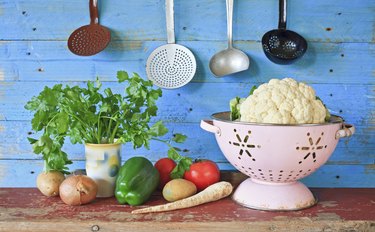
Any well-equipped kitchen includes a number of utensils designed for straining foods, primarily to separate solids from liquids. The slotted spoon you use for lifting a poached egg from its water bath is a strainer, after its fashion, and so is the larger round "spider" used for the same purpose in professional kitchens -- or home cooks familiar with Asian cuisines. The most useful and versatile examples of the strainers fall into one of two broad categories.
Colander-Type Strainers
Video of the Day
Colander-type strainers are stamped or molded with a regular pattern of holes, which provide an exit for fats or liquids to drain away from solid foods. In typical usage, the colander stands on its own stubby feet as you pour your mixed liquids and solids through it. A few variations on the basic design are used rather differently. Some colander-type strainers are flat, and circular or semi-circular in shape. They're held to the lip of a pot as you pour, to let the liquids out and restrain the solids. Restaurants use a special conical colander, called a "china cap," that's held in one hand or rested across a pot as you pour.
Video of the Day
Mesh-Type Strainers
Mesh-type strainers consist of a rigid frame and handle, supporting a shallow bowl of fine or coarse mesh. They're typically hand-held and used for straining modest quantities of food. Fine-mesh strainers can also double as sifters, returning lumpy flour or powdered sugar to its original light and fluffy condition. Restaurants use special drum-shaped "tamis" sifters especially for that purpose. A tamis can also be used to puree soft-cooked foods, by forcing them through the fine mesh with a spatula. As with colanders, there's also a special conical mesh sifter used in restaurants. Called a "chinois," it can be used as a strainer or -- like a tamis -- foods can be forced through it to make a puree.